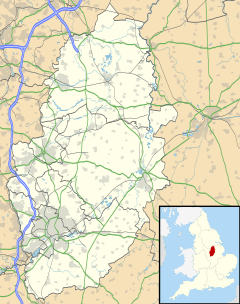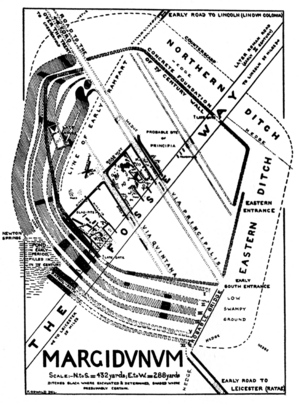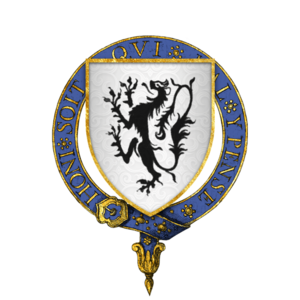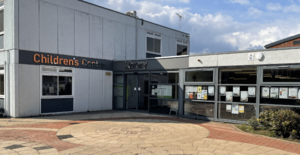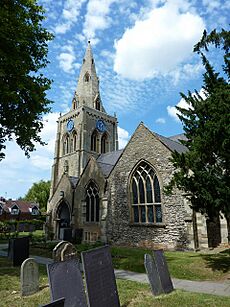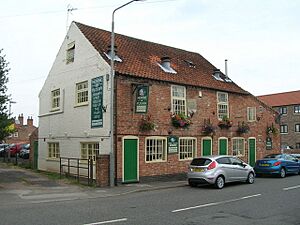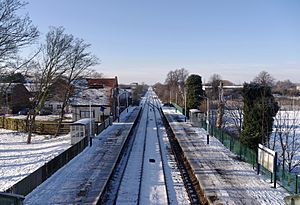Bingham, Nottinghamshire facts for kids
Quick facts for kids Bingham |
|
|---|---|
| Town and civil parish | |
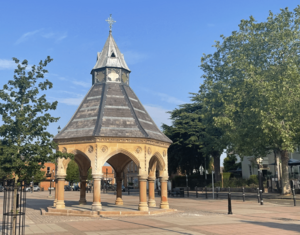 Bingham Market Square |
|
Parish map |
|
| Area | 4.72 sq mi (12.2 km2) |
| Population | 10,080 (2021 UK census) |
| • Density | 2,136/sq mi (825/km2) |
| OS grid reference | SK 70334 39950 |
| • London | 105 mi (169 km) SSE |
| District |
|
| Shire county | |
| Region | |
| Country | England |
| Sovereign state | United Kingdom |
| Post town | NOTTINGHAM |
| Postcode district | NG13 |
| Dialling code | 01949 |
| Police | Nottinghamshire |
| Fire | Nottinghamshire |
| Ambulance | East Midlands |
| EU Parliament | East Midlands |
| UK Parliament |
|
Bingham is a lively market town and civil parish in Nottinghamshire, England. It's about 9 miles (14.5 km) east of Nottingham. The town is also 12 miles (18.8 km) south-west of Newark-on-Trent. In 2021, about 10,080 people lived in Bingham.
Bingham is connected with Wallenfels in Bavaria, Germany. This is called "twinning." Music groups from both towns visit each other. Bingham also hosts a fun beer festival every year.
Contents
Where is Bingham?
Bingham is located near two important roads. These are the A46 and the A52. The A46 follows an old Roman road called the Fosse Way. This road runs between Leicester and Newark-on-Trent. The A52 connects Nottingham and Grantham.
Bingham is surrounded by several smaller communities. These include Radcliffe-on-Trent and East Bridgford. Other nearby places are Car Colston and Scarrington.
Bingham's Past
Early Settlers: Romans and Celts
The first known people here were the Coritani. They were a Briton tribe. They called their fort "Marigidun." This name meant "fort-of-the-king's plain." Later, the Romans came and built a fort. They called it "Margidunum." Its ruins are just north of Bingham. The Romans also had a settlement called Ad Pontem nearby.
Anglo-Saxon Times
The area was known by different names back then. The Anglo-Saxons called it Byngehamshou Hundred. The Danish called it Binghamshou Wapentake. The name "Bingham" comes from an Angle chief named "Bynna." "Ing" means "of," and "ham" means "homestead." So, it means "Bynna's homestead."
This Anglo-Saxon village started around the 600s. It was shaped like an oval and had a ditch around it. The villagers lived in huts. They built their village near marshland. This gave them water. Later, this land was drained. It became very good for farming. Bingham became Christian around the same time as the rest of the Kingdom of Mercia.
Norman Conquest and Growth
After the Normans took over England, the Domesday Book was written in 1086. It shows that Bingham had about 300 people. Most of the free landowners were Danes. The first Norman owner was Roger de Busli. But he died without children. So, Bingham Manor became the King's land. Even today, much of Bingham is still Crown land.
Bingham was given a special right in 1341. This allowed it to hold a market.
Tudor Era Farming
During the time of Elizabeth I, Sir Bryan Stapleton owned Bingham Manor. Farming in Bingham was very shared. There were common areas called moors. People used them to keep pigs and gather firewood. To manage these shared lands, the Manor Court met. It had five elected officers. They made sure the fields, grazing land, and forests were used fairly.
English Civil War
During the English Civil War, Bingham was in a tricky spot. It was between the Parliamentary side in Nottingham and the Royalist side in Newark. Prince Rupert, a Royalist leader, camped near Bingham. Many Parliamentary soldiers found safety in Bingham. This suggests the town supported the Parliament.
Industrial Revolution Changes
In 1801, Bingham had 1,082 people. This number grew to 2,054 by 1851. But then it dropped to 1,604 in 1901. After 1951, Bingham started to grow a lot. Many buildings in the town center are newer. Most of the growth happened after World War II.
The town first grew during the Industrial Revolution. More homes were needed for the growing workforce. The railway arrived in 1851. But then, farming in England declined. Also, small home businesses like lace knitting were replaced by factories in Nottingham. This led to tough times for Bingham. The town faced high unemployment. It didn't fully recover until after World War II.
Modern Bingham: Post-War Growth
After World War II, many houses in Bingham were checked. Some were fixed, and some were taken down. It was decided that farms should stay in the countryside. They would not be mixed with homes. Some old buildings were removed. This changed how the town looked.
The 1960s and 1970s saw lots of new houses being built. More recently, a new housing area called Romans' Quarter started in 2018. It is named after the nearby Roman site of Margidunum. About 1,000 new houses are planned there.
What Bingham Offers
Schools and Library
Bingham has five schools for young people. These include Robert Miles Infants School and Robert Miles Junior School. There is also Carnarvon Primary School. Bingham Primary School & Nursery is another option. For older students, there is Toot Hill Comprehensive School.
Bingham's library has been around since the late 1950s. It started as a small "charity penny library." In 1973, it moved to Eaton Place. It is still there today.
Churches
The Church of St. Mary and All Saints, Bingham is an old medieval building. It was restored in the 1800s and early 1900s. It has eight bells and an old organ.
A new Bingham Methodist Church opened in 2016. It is also at Eaton Place. It has a social center.
Shopping and Businesses
Bingham has an open-air food market. It happens every Thursday in the Market Place. A farmers' market is held there on the third Saturday of each month. Bingham provides many services for nearby villages. These include shops and medical care.
North of the town, there is an industrial estate. It has about 40 businesses. Some of the larger ones include Midland Filtration and Screwfix.
Fun and Sports
Bingham has several pubs, like The Butter Cross and The Horse & Plough. There is also a bar/bistro called Gilt.
The Bingham Arena has great sports facilities. It has a swimming pool and a large hall. This new center replaced the old Bingham Leisure Centre.
Bingham has Scout troops with about 140 young members.
The town has many sports clubs:
- British Canoe Union
- Bingham Town Youth Football Club
- Bingham Cricket Club
- Bingham Rugby Club
- Bingham Badminton Club
- Bingham Taekwondo Club
- Bingham Lawn Tennis Club
- Bingham Leisure Centre Archery Club
- Bingham Sub-Aqua Club
- Bingham Penguins – Swimming Club
- Vale of Belvoir Cycling Club
- Vale Judo Club
Media in Bingham
Local news and TV shows come from BBC East Midlands and ITV Central. You can also get signals from other BBC and ITV regions.
Local radio stations include BBC Radio Nottingham and Hits Radio East Midlands. Other stations are Capital Midlands and Smooth East Midlands.
The local newspapers are the Nottingham Evening Post and Newark Advertiser.
Bingham on Screen
Bingham has been a filming location for movies and TV shows.
The film Twenty Four Seven had scenes shot in Bingham. These included Toot Hill top field and the Linear Walk. Bingham Boxing Club was also used.
Bingham has appeared in two episodes of Auf Wiedersehen, Pet. It was also seen in some episodes of Crossroads, Woof!, and Boon.
Dickinson's Real Deal was filmed at Bingham Leisure Centre in 2015. It was shown on ITV1 in 2016.
Four in a Bed also filmed an episode at Bingham Townhouse Hotel in 2016.
Famous People from Bingham
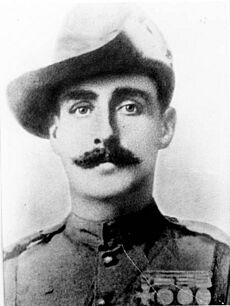
- Robert Lowe, 1st. Viscount Sherbrooke (1811–1892): A statesman born in Bingham.
- Frank Miles (1852–1891): An artist, architect, and plant lover.
- Harry Churchill Beet (1873–1946): He won a Victoria Cross for bravery in South Africa in 1900. He was born near Bingham.
- Mary Joynson (1924–2013): She was a director of Barnardo's, a children's charity. She was born in Bingham.
- Spencer Cozens (born 1965): A musician, writer, and producer from Bingham.
Sports Stars
Several cricketers were born in Bingham:
- Thomas Foster (active 1820s)
- Thomas Brown (1848–1919)
- Philip Miles (1848–1933)
- John Brown (born 1862)
- Albert Widdowson (1864–1938)
- Stafford Castledine (1912–1986)
- Jonathan Stenner (born 1966)
Joe Heyes (born 1999) is a professional rugby player from Bingham. He plays for Leicester Tigers.
Getting Around Bingham
Trentbarton provides regular bus services into Nottingham.
Bingham's main railway station has hourly trains. These go to Nottingham and Grantham. You can also take a train to Skegness on the Poacher Line.
Another station, Bingham Road, used to be south of town. It closed in 1951 for passengers. Now, the old railway path is a greenway for walking and cycling.
Bus services are also provided by Vectare and Centrebus.
The A46 road west of Bingham was improved in 2013. It is now a dual carriageway. The A52 bypass south of the town opened in 1986.
Images for kids


